PRIVATE CYRIL ERNEST BARRETT
Cyril Ernest Barrett was born in December 1919, to parents Joseph and Ann Barrett of 19, Middle Row. At the outbreak of the Second World War he was working as a house painter and decorator. He enlisted into the 4th (Territorial) Battalion, The Oxfordshire & Buckinghamshire Light Infantry, as a Private. He then volunteered for special services and was attached to 3 Commando, joining No 1 Troop. He married Margaret, from Oakville, Canada, in Chipping Norton in 1942.
In August 1942 No. 3 Commando was involved in the ill-fated Operation Jubilee, an exploratory raid on Dieppe in France. Objectives included seizing and holding a major port for a short period, both to prove that it was possible and to gather intelligence. Upon retreat, the Allies also wanted to destroy coastal defences, port structures and all strategic buildings. The raid had the added objectives of boosting morale and demonstrating the firm commitment of the United Kingdom to open a western front in Europe. The plan called for a frontal assault on the port by the Canadian 2nd Division. Before this would take place, however, Troops from No. 3 and 4 Commandos would land at beaches on the eastern and western flanks and neutralise two German artillery batteries that were covering the main anchorage. No. 3 Commando was assigned the task of attacking the Goebbels Battery, landing on the eastern flank. The battery was located near Berneval-le-Grand, about half a mile from the sea with steep cliffs in front of it. It was decided that No. 3 Commando would land on two beaches to the east and west of the battery, from which gullies rose towards the battery and which would provide concealment while the commandos approached.
As the convoy of landing craft and other vessels ferried the commandos across the English Channel, however, they had a chance encounter with a German tanker escorted by a number of armed trawlers which proceeded to fire upon them. In the confusion that followed a number of the landing craft were damaged and forced to turn back, while others were reported as missing and believed sunk. As a result the decision was made to abandon the attack.
Nevertheless, unbeknown to their commanders and each other, and having lost communications, the seven landing craft that had been reported missing made for their assigned beaches, determined to press on with the attack. In the end two parties landed, one party consisting of six craft carrying approximately 120 men landed on the beach opposite Le Petit Berneval to the east of the battery—Yellow I—while the other, consisting of only one craft of 20 men from No. 6 Troop landed to the west at Yellow II.
Of the 120 men that landed at Yellow I, 37 were killed including Private Barrett, 81 were captured, mostly after having been wounded, and just one managed to evade capture and return to Britain. However valuable lessons were learned for the Normandy Landings in June 1944.
Private Cyril Barrett was reported missing on 19th August 1942, later confirmed to have been killed in action. He was aged 22. his body was never recovered, he is commemorated on the Brookwood Memorial in Surrey for those with no known grave.
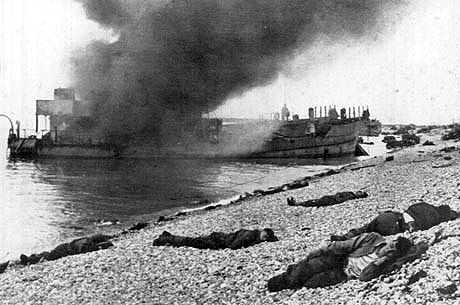

PRIVATE ERNEST EDWARD BOWSER
He was the son of Ernest and Alice Bowser, having been born in Plaistow in Essex. At the time of his death he had been living at 1, Alfred Terrace, Chipping Norton. His father won the Military medal for bravery in the field, whilst serving with the Royal Artillery in World War One. He was serving as a Private in the 4th Battalion, The Parachute Regiment when he was killed in action on 27th October 1944 during Operation Manna, the airborne capture of Megara airfield near Athens, Greece. He was aged 25. He is buried in Phaleron War Cemetery in Greece. He is not on the Town war memorial.
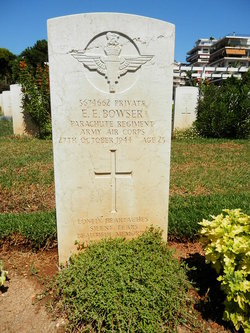
.jpg?timestamp=1698598534152)
PRIVATE JOHN CAPEL BUTLER
He was born in July 1915, the son of Herman and Emily Butler of 60, West Street, Chipping Norton. His father had served in the First world War as a Sergeant in the Gloucestershire Regiment until being wunded in action an invalided out in 1917, the family moving to the town shortly after. John Butler worked as a carpenter and joiner and married Ivy Barnes of Bloxham in 1940. He was called up and joined the 7th Battalion, The Oxfordshire & Buckinghamshire Light Infantry as a Private.
The 7th Battalion, Oxfordshire and Buckinghamshire Light Infantry formed part of the 56th London Division, they left the United Kingdom in late August 1942. The division was sent to Persia and Iraq Command and the battalion later fought in the final battle in the Tunisia Campaign in April 1943. The battalion made a successful attack at Enfidaville following a 3,000-mile road move from Iraq. In the Italian Campaign, 7th Ox and Bucks took part in the landings at Salerno in September 1943 and suffered heavy casualties. On 17th January 1944 they took part in the first assault in the Battle of Monte Cassino, near the coast, when the British X Corps (56th and 5th Divisions) forced a crossing of the Garigliano River to engage the German 94th Infantry Brigade. The Battle of Monte Cassino was a costly series of four assaults by the Allies against the Winter Line in Italy held by the Germans and Italians during the Italian Campaign with the intention to breakthrough to Rome. At the beginning of 1944, the western half of the Winter Line was being anchored by Germans holding the Rapido, Liri and Garigliano valleys and some of the surrounding peaks and ridges. Together, these features formed the Gustav Line. Monte Cassino, a historic hilltop abbey dominated the nearby town of Cassino and the entrances to the Liri and Rapido valleys, but had been left unoccupied by the German defenders. The Germans had, however, manned some positions set into the steep slopes below the abbey's walls.
Private John Butler was killed in action during the Battle of Monte Cassino on 23rd January 1944. He aged 28 and is commemorated on the Cassino Memorial, Italy for 4000 allied soldiers with no known grave.
He is also remembered on Bloxham War Memorial.

LIEUTENANT PETER JOHN CALLAHAN
He son of John and Daisy Callahan of Chipping Norton, and before the war had worked for Barclay's bank. He joined the Officer Cadet Unit and was commissioned as a 2nd Lieutenant into the(3rd Reconnaissance Regiment) Royal Armoured Corps which had been formed out of B Squadron, 3rd (8th Battalion, The Royal Northumberland Fusiliers) Regiment on 12th December 1943.
He landed with his regiment on Sword Beach on D-Day, 6th June 1944, and promoted to Lieutenant on 12th June 1944. As part of the 3rd Infantry Division and fought through the Battle of Normandy at Caen, Bourguébus Ridge and Mont Pinçon. They crossed into Belgium and Lieutenant Peter Callahan was accidentally killed on 20th September 1944 at Petit Brogel on his 20th birthday. He was initially buried in the local cemetery but re-interred into Leopoldsburg Military Cemetery, Belgium in 1946.

DRIVER SIDNEY ERIC DEE
He was born in Warwick in 1912 and married May Mills in 1932 in Chipping Norton and was father of two children, Edith Rose and Freda. They lived at 5, Hailey Road in Chipping Norton and Sidney worked as a builder's labourer. He was called up and served as a Driver with the Royal Army Service Corps and was still serving when he died of a heart attack at home in Hailey Road on 16th March 1946 in Chipping Norton. He was aged 33 and is buried in Chipping Norton Cemetery. LIEUTENANT WILLIAM ALFRED FREEBORN
LIEUTENANT WILLIAM ALFRED FREEBORN
He was born in July 1911 in Headington, the son of George Freeborn, a butcher, and his wife Alice. The family moved to Old Bank House, Market Street, Chipping Norton where his father was a master butcher. William worked as an engineer, visiting America, Australia and Canada. He married to May Maclennan and lived at Roselea, Lower Largo, Fifeshire. He joined the RNVR Clyde Division in April 1937 and was made a temporary sub-Lieutenant on 1st May 1940. He served on the Janethea IV, below, a motor launch requisitioned by the Navy as a coastal patrol vessel. As HMS Corax she assisted in the Dunkirk evacuation.

He then commanded HMS Elsie Cam, a mine sweeping trawler from August 1941 until September 1943 and was promoted Lieutenant in March 1942. He then commanded HMS Motor Minesweeper 44, (below), until 1st December 1943.

Lieutenant William Freeborn was attached to HMS Victory Training Establishment when he was diagnosed with cancer and died of his illness at his home on 31st July 1944. He was aged 33 and is buried in Largo cemetery, Fifeshire.

STOKER 1st HORACE GARDNER
He was born in October 1904, the son of Wilfred and Maud Gardner of 4, Victoria Place, Chipping Norton.
He had been working as a boat repairer when he joined the Royal Navy in Portsmouth on 8th May 1929 and trained as a stoker. He was assigned to HMS Osprey the anti-submarine establishment at Portland as a Stoker 1st class on 12th February 1931. He served on the destroyers HMS Heather and HMS Woolston and on the patrol vessel HMS P59, below, as part of the Portland anti-submarine flotilla. Home on leave in summer 1931 he married Hilda Taylor in Chipping Norton

He then joined the crew of the C class light cruiser HMS Coventry in December 1932, serving with the Home Fleet. On 2nd February 1935 he was back at HMS Osprey and served on board the armed trawlers HMS Blackwater and HMS Topaze on anti submarine duties. On 1st February 1938 he joined the crew of HMS Vernon a minelaying tender and served with her until February 1940. On 2nd April 1940 he joined the Crown Colony class light cruiser HMS Fiji. below.
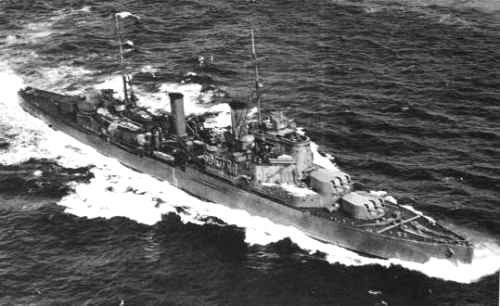
She was commissioned on 5th May 1940, and initially joined the Home Fleet. On 31st August 1940 she sailed for the African Atlantic coast to take part in Operation Menace, the attack on Dakar. Before she could join the task force, Fiji was damaged by a torpedo from a U-Boat on 1st September and had to return to Britain for repairs, which lasted for the next six months. She was fitted with radar and her Anti-Aircraft armament was increased. She returned to service in March 1941 and was assigned to patrol the Denmark Strait for German raiders. In April she was reassigned to Force H to blockade the German heavy ships then stationed at Brest. With Force H, she sailed into the Mediterranean to support operations to relieve Malta.
On completion of these duties she participated in the Battle of Crete. On 22nd May 1941 she was acting in company with the destroyers HMS Kandahar and HMS Kingston shortly after the loss of HMS Gloucester. These ships fought on and shot down one attacking aircraft and damaged two others. She finally expended all of her AA ammunition fighting off numerous air attacks that persisted for two hours. She was attacked and hit by several bombs from Messerschmitt Bf 109s before an aircraft of Jagdgeschwader 77 dropped a bomb close alongside to port. This blew in Fiji’s bottom plates and caused a list to port. Fiji lost power and came to a standstill. She was now largely defenceless, having practically exhausted her 4 inch ammunition. She was then hit by three bombs dropped by a Junkers Ju 88 from Lehrgeschwader 1 piloted by Gerhard Brenner. Captain Peveril William-Powlett gave the order to abandon ship and at 2015 Fiji rolled over and sank. The two destroyers dropped floats and withdrew to the south. They returned after dark to pick up 523 survivors. 241 men had gone down with the ship.
Stoker 1st Class Horace Gardner was one of those lost on the 23rd May 1941. He was aged 36 and is commemorated on the Portsmouth Naval Memorial, his body never being recovered from the sea.

GUNNER LESLIE CHRISTOPHER GILBERT
He was born in Chipping Norton, in April 1916. the son of Christopher and Frances Gilbert. Before the war he had worked as a brick moulder and married Beryl Shepard in 1939, and lived at 5, Pembridge Terrace, Chipping Norton.
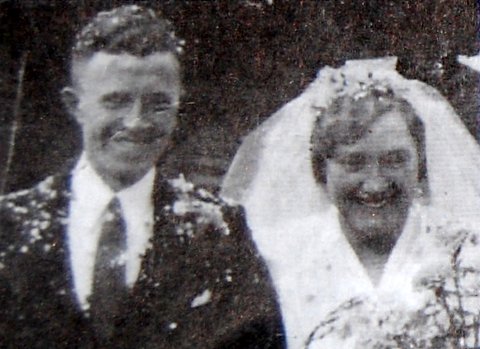
The 135th were a Territorial regiment and in October 1941 they boarded the Polish ship "Sobieski" (below) at Gourock in Scotland, as part of the 18th (East Anglian Infantry) Infantry Division and sailed across the Atlantic in convoy, in somewhat cramped conditions, to the Canadian port of Halifax.

There they boarded the USS Mount Vernon, a converted passenger liner, with better conditions and food, but still packed with 9,00 troops aboard. She sailed from Halifax in November 1941, dodging a U-boat pack and making first landfall at Cape Town. During the Atlantic crossing the ships company learnt of the attack on Pearl Harbour and the United States entry into the war, which lifted the spirits of the men. During the two day stop over they enjoyed the hospitality of the Cape Town residents before sailing on to Bombay. They arrived at their destination, Singapore , on 13th January 1942, during a tropical rain storm, which protected the disembarking troops from Japanese bombers, which had been carrying out massed raids on the town.

Based on a rubber plantation near the causeway that linked Singapore Island with the mainland, they were soon in action to defend the Malay Peninsula and had some success before falling back on the island.They continued the action on Singapore Island before they had to destroy their guns and surrender to the Japanese on 15th February 1942. Their commanding officer was Lieutenant-Colonel Peter Toosey, who defied orders to evacuate from Singapore, to remain with his men in captivity. The men, including Leslie Gilbert, were sent to Tamarkan camp in Thailand to build rail bridges over the Khwae Noi River, part of the "Death Railway" from Bankok to Rangoon.
After the completion of the bridges the so-called fit men were put aboard the Hofuku Maru, a tramp steamer (below), to work on the Japanese mainland. About 1,200 prisoners were crammed into 2 holds with not enough room to lie down all at once. Food was meagre, about a cup of rice a day, barely enough water and sanitary conditions appalling.
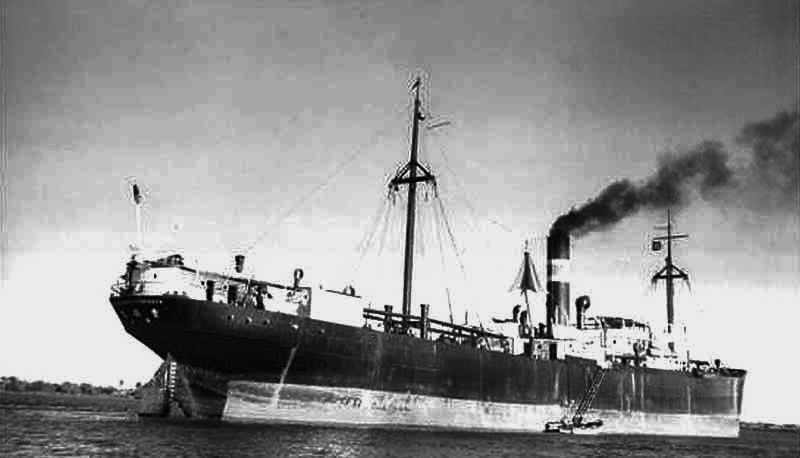
She sailed from Singapore to Miri, Borneo, on 4th July 1944, as part of convoy SHIMI-05 consisting of 10 ships, 5 of which carried, in total, 5,000 POWs. At Borneo, the Hofuku Maru left the convoy with engine problems, and sailed on to the Philippines, arriving on July 19th. She remained in Manila until mid-September while the engines were repaired. The POWs remained on board, suffering terribly from disease, such as beri-beri, hunger, and thirst. Around 90% of the prisoners were reckoned to be incapacitated by illness.
On September 20 1944, the Hofuku Maru and 10 other ships formed Convoy MATA-27, and sailed from Manila to Japan. The following morning, the convoy was attacked 80 miles north of Corregidor by more than 100 American carrier planes. All eleven ships in the convoy were sunk. The Hofuku Maru was hit by three bombs and sank in under 5 minutes with most of the prisoners unable to escape from the holds, 1,047 of the 1,289 British and Dutch POWs on board died. , including Chipping Norton's Leslie Gilbert. was serving as a Gunner Leslie Gilbert was one of those lost on 21st September 1944. He was aged 28 and is commemorated on the Singapore Memorial, for those with no known grave.

CORPORAL LESLIE ROBERT HARRIS
Leslie Robert Harris was born on the 28th October 1920 and was the first born son of Elizabeth Harris of Ragland Way, Chipping Norton. He worked at the Co-operative in Chipping Norton. During this time he enlisted into the local company of the 4th Battalion of the Oxfordshire & Buckinghamshire Light Infantry, where he began his training as rifleman.
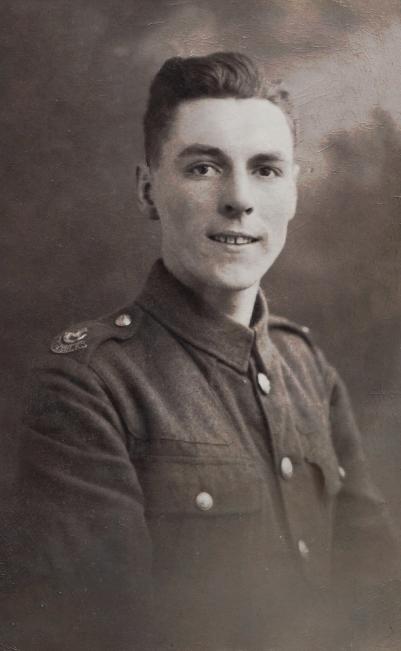
Leslie was called up in August 1939 before the outbreak of war when the country prepared to deploy troops to France as part of the BEF as a result of anticipated hostilities brewing in Europe. Fortunately the call never came and Leslie remained in England and began to further his infantry training where he reached the rank of Corporal and was assigned to the 1st Battalion Gordon Highlanders. The 51st Highland Division had returned to Britain in November 1943, already battle hardened from campaigns in North Africa and Italy and in much need of rest.
In March 1944 the division moved to East Anglia and on 5th April 1944 transferred from 30th Corps to 1st Corps and commenced training for the planned invasion of main land Europe as part of Operation Overlord. During this time Leslie married his sweetheart Gertrude Irene Hodson from Wellingborough in a small ceremony with only a small number of family present.

In early June, Leslie, along with the rest of his battalion travelled south to London and then onto Portsmouth where they joined the massing allied forces to prepare for the invasion. Leslie landed with the Gordon Highlanders and other regiments of the 51st Highland Division on the 7th June 1944 on Sword beach. After spending a brief period supporting the 3rd Canadian Infantry Division, the Gordons were sent across the River Orne, and spent two months supporting the 6th Airborne Division in its bridgehead.During this period they fought in many difficult actions around Breville between 11th and 13th June, the Battalion ran into stiff opposition in the area of St.Honorine and Demouville. Their attacks were driven off and they assumed a defensive position north of St. Hororine. On the 11th July they were part of a night attack on Colombelles, a village with a large factory and chimneys which acted as excellent observation points for the enemy. Despite a determined attempt the position was not taken, a German armoured counterattack destroyed 10 of the 11 Sherman tanks supporting the infantry and at 0830 the next morning the Brigade withdrew back to St. Hororine and Longuecal. On the 18th of July the allies launched Operation Goodwood an attack spearheaded by three armoured divisions focused on the German-held Bourguébus Ridge. The idea was to force the Germans to commit their armoured reserves in a series of costly counterattacks. The Germans were able to stop the British advance short of Bourguébus Ridge but had been shocked by the weight of the attack and preliminary aerial bombardment. When Operation Goodwood ended on 20th July, the armoured divisions had broken through the outer German defences and advanced 7 miles but had been stopped short of Bourguébus Ridge, only armoured cars having penetrated further south and beyond the ridge. While Goodwood failed in its primary aim, it forced the Germans to keep powerful formations opposite the British and Canadians on the eastern flank of the Normandy beachhead.
The 1st Battalion Gordon Highlanders along with other elements of First Canadian Army launched an attack that was codenamed ‘Operation Totalise’. The intention was to break through the German defences south of Caen on the eastern flank of the Allied positions in Normandy and exploit success by driving south, to capture the high ground north of the city of Falaise. The goal was to collapse the German front and cut off the retreat of German forces fighting the Allied armies further west.
Corporal Leslie was wounded during this operation and was taken immediately to a field hospital for medical treatment. He died of his wounds on the 24th August 1944 aged 24 and was laid to rest in a small orchard in Hermanville Sur Mer. Located approximately 15km north of Caen this later became Hermanville War Cemetery.

GUNNER THOMAS JAMES HARRIS
He was the son of George and Louisa Harris of 11, West End, Chipping Norton. He married Mary Whitehead in Brackley in 1935 and moved to Bourton-on-the Water and had two sons and two daughters. He was called up and joined the 64th (The Queen's Own Royal Glasgow Yeomanry) Anti- tank Regiment, The Royal Artillery as a Gunner. They were a Territorial Army Unit mobilised in September 1939 and served in the United Kingdom as part of until March 1942. They then moved to North Africa with the 78th Division, equipped with 17 pounder anti-tank guns. The 78th was formed specifically for Operation Torch, landing at Algiers in November 1942. The Axis forces defeated at El Alamein withdrew into Tunisia along the coast through Libya, pursued by the Allied Eighth Army. By mid April 1943, the combined Axis force was hemmed into a small corner of north-eastern Tunisia and the Allies were grouped for their final offensive. Medjez-el-Bab was at the limit of the Allied advance in December 1942 and remained on the front line until the decisive Allied advances of April and May 1943. Gunner Thomas Harris died of accidental suffocation on 17th May 1943 near the town of Thibar. He was aged 39, and originally buried there, but was re-interred Medjez-El-Bab War cemetery in Tunisia.

LANCE CORPORAL VICTOR PERCIVAL HARRIS
He was the son of Phillip and Fanny Harris of 2, Market Street, Chipping Norton. Before the war he worked as a warper at Bliss Mill and served as an Air Raid Protection warden there at the outbreak of war. He was a member of The Chipping Norton Temperance Brass Band.
.jpg?timestamp=1561186071562)
He was called up, enlisting into the Royal Marines and posted to S Searchlight Battery, the Royal Marines Mobile Naval Base Defence Organization (Landing) in Egypt, where he was made up to Lance Corporal. The function of the M.N.B.D.O. was to provide the Fleet with a base in any part of the world, whether on the coast of a mainland or an island, within a week, and to defend it when prepared. The Unit was carried in specially equipped merchant vessels. The landing group is responsible for the collection of the required material, and for putting it ashore in landing craft, and also the transporting of it once it has been landed. The Group then completes its function by building wharves or converting existing jetties, making roadways from the beach, and erecting such buildings as may be necessary. The defence side of the Organization is divided into artillery groups with naval coastal guns, anti-aircraft and anti-tank guns, and searchlights all to co-operate with each other. It had a Land defence Force consisting of rifle companies, machine gun sections and light artillery batteries. The unit was involved in Operation Torch the landings in French North Africa in 1942, Lance Corporal Victor Harris contracted smallpox and was evacuated to the 19th General Hospital in Alexandria where he died on 22nd June 1943. He was aged 23 is buried in Fayid War Cemetery in Egypt. The unit was involved in Operation Torch the landings in French North Africa in 1942,
Lance Corporal Victor Harris contracted smallpox and was evacuated to the 19th General Hospital in Alexandria where he died on 22nd June 1943. He was aged 23 is buried in Fayid War Cemetery in Egypt.

GUNNER PHILLIP LIONEL BERNARD HIATT
He was been in July 1923, the son of of Ernest and Linda Hiatt, of Over Norton. He was called up and joined the 8th Medium Regiment, The Royal Artillery as a Gunner,
H
The 8th Medium Regiment was formed in India in 1941 and moved into Burma in 1943 where it remained to the end of the war. They were equipped in 1943 with the 5.5 inch gun. They were part of the 4th India Corps in Imphal, Assam, India.
The Battle of Imphal took place in the region around the city of Imphal, the capital of the state of Manipur in North-East India from March until July 1944. Japanese armies attempted to destroy the Allied forces at Imphal and invade India, but were driven back into Burma with heavy losses. Together with the simultaneous Battle of Kohima on the road by which the encircled Allied forces at Imphal were relieved, the battle was the turning point of the Burma Campaign, part of the South-East Asian Theatre of the Second World War.
Gunner Phillip Hiatt was killed in action during the Battle of Imphal on 8th May 1944. He was aged 20 and was buried near where he fell being re-interred in Imphal War Cemetery, India in 1945.
He is also remembered on the Over Norton War Memorial.

ORDINARY SEAMAN GEORGE LEONARD HOLTOM
He was born in December 1925 to Florence Mabel Holtom, who was only 17. He was educated at Kingham Hill School and had worked at Craft’s Mill before joining the Royal Navy.
He joined the crew of His Majesty’s Motor Launch 916, The first Fairmile Type B motor launch (below) was completed in September 1940 and some 650 were produced during the war. Initially designed as submarine chasers they went on to fill many roles including gunboat, motor torpedo boat and minesweeper. After the war many were turned into pleasure craft and a few still survive._LI.jpg?timestamp=1575291887872)
After the breakout from Normandy by the Allied armies, in August 1944, the German forces held on stubbornly to the French and Belgian English Channel ports. This forced the Allies to bring all supplies for their rapidly advancing armies from the artificial harbour they had constructed off the beaches of Normandy, and from Cherbourg. Because of its port capacity Antwerp became the immediate objective of the British 21st Army Group commanded by Bernard Montgomery. While Antwerp fell to Montgomery on September 4th no supplies could be landed there until the German forces holding the lower reaches of the Scheldt, between Antwerp and the North Sea, were removed and the approaches swept for mines.ML 916 in company with another Motor Launch, swept with Oropesa sweeps (for moored or contact mines) all the way to Antwerp.
They were the first Royal Navy vessels to reach Antwerp and were given an incredible reception by the Mayor and people of Antwerp. On 8th November 1944 ML916 with her sister boat ML906 was laying a smoke screen when she detonated a magnetic mine off Walsoorden, Zeeland, Holland. The ship was blown into the air and disintegrated. There were only two survivors. Nineteen of her crew, below, were killed. 
Six badly burnt bodies were recovered, including Ordinary Seaman George Holtom. He was aged 18 and is buried in Bergen-op-Zoom War Cemetery, Netherlands.

FLYING OFFICER RONALD JACQUES
Ronald Jacques was born in November 1914, the son of Jack and Mary Anne Jacques, licensees of the Kings Arms, 18, West Street, Chipping Norton. He married Olga Slack in Sheffield in 1936 and they lived in the city where he was a schoolmaster. He joined the Royal Air Force Volunteer Reserve and trained as a Navigator. He was commissioned as a Pilot Officer on 20th November 1942 and was promoted to Flying Officer on 20th May 1943. He joined 463 Squadron of the Royal Australian Air Force flying Avro Lancasters from RAF Waddington. He took off on 10th May at 2200 aboard Avro Lancaster Mk 1 serial no LL882, JO-J, to bomb marshalling yards in Lille, France.
His plane was shot down by a Heinkel HE 219 night fighter piloted by Lieutenant Hans Schmitz of 4/ NJG1 and crashed into a flooded clay pit at a brickworks in Langemarck in Belgium killing all aboard. The wreckage was recovered from the pit after it was drained (below).
Flying Officer Ronald Jacques was killed in action on 11th May 1944. He was aged 28 and is buried in Wevelgem Communal Cemetery in Belgium.
 (1).jpg?timestamp=1557559572217)
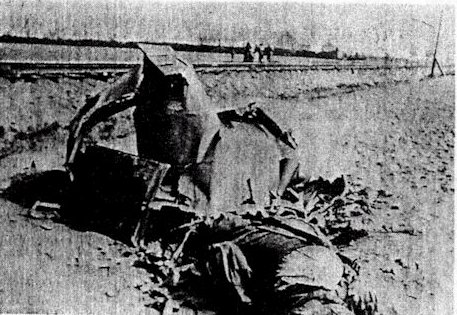
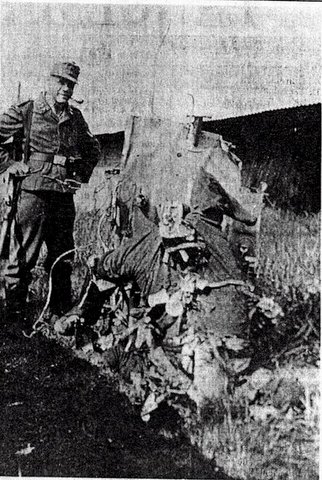
 e
e
SERGEANT JOHN HAROLD JEFFRIES
He was born in July 1921, the son of William Cyril and Doris Jeffries of 34, New Street, Chipping Norton. John Jeffries joined the Royal Air Force from school as a "brat", part of the 33rd entry at No 1 School Technical Training at RAF Halton.
After training he was posted to No 10 Squadron based at RAF Leeming in North Yorkshire as a Flight Engineer operating the Handley Page Halifax Mk II four-engine heavy bomber.
He was Flight Engineer on board Halifax ZA-M V9986 which took off from RAF Leeming on 26th February 1942 at 1823 on a mission to bomb a floating docks at Kiel. Nothing more was heard from the aircraft which disappeared without a trace. He was aged 21 and is commemorated on the Runnymede Memorial, Surrey for aircrews lost over Europe with no known grave.
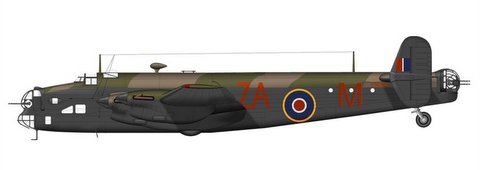

FLYING OFFICER LESLIE WILLIAM JOHN KING DFC
Known as Bill, he was the son of William and Emily Maria King, of Enstone, and had joined the Royal Air Force Volunteer Reserve in September 1939 at RAF Uxbridge and trained as an engine fitter on ground crew. In September 1942 he joined 57 Squadron and had qualified as a Flight Engineer with the rank of Sergeant. They were based at RAF Scampton flying the Vickers Wellington Mk111, converting to the Avro Lancaster from September 1942. He was promoted to Flight Sergeant and took part in the famous low level raid on the Schneider factory at Le Creusot, on 17th October 1942, being seriously wounded when a bird strike shattered part of his windscreen. He was hospitalised until January 1943. Returning to operations he was commissioned as a Pilot Officer on 9th May 1943 and by September that year had completed 29 missions with 57 Squadron, including raids on Wilhemshaven, Nuremberg, Cologne, Hamburg, Munich, Essen and Spezia in Italy.
In October that year he was awarded the Distinguished Flying Cross for his persistent achievements but citing the incident in October 1942:
“As flight engineer Pilot Officer King has completed many sorties and displayed skill and keenness of a high order. On one occasion, at an early stage of a daylight sortie on Le Creusot, Pilot officer King was badly injured in the face by flying splinters when the windscreen of his plane shattered. Although in considerable pain and unable to see, this gallant flight engineer refused to allow other members of the crew to leave their stations and come to his aid. During the remainder of the flight he showed great fortitude and constantly attempted to render assistance. His courageous example proved most inspiring. Upon recovery, Pilot Officer King resumed operations and has executed his duty with rare zeal"
In early November 1943 he converted to the Avro Lancaster and then joined 617 Squadron, picked by Wing Commander Leonard Cheshire for his personal crew. He is on the far left on the photo below.
 with a dambusters crew.jpg?timestamp=1588836866717)
In January 1944 the Squadron moved to RAF Woodhall Spa carrying out several raids on France. Bill King was promoted to Flying Officer on 25th January.
The squadron began a series of accurate attacks on industrial targets in occupied Europe between 3rd and 24th March 1944. Targets were an aircraft factory at Albert, the La Ricamerie factory, the Michelin tyre factory at Clermond-Ferrand, explosives factories at Bergerac and Angoulême and an aircraft engine factory at Lyon. Wing Commander Cheshire along with Bill King as his flight engineer had been using their Lancaster to mark targets but in April 1944 Cheshire was presented with a single seat Mustang fighter by the Americans, which he successfully used to mark targets.
As F/O King was now redundant he was transferred to the crew of Flight Lieutenant John Edward DFC. On June 5th and 6th they were involved in "Operation Taxable" to deceive the Germans into thinking the Allied invasion was taking place in the Pas de Calais. They returned to more conventional targets from 8th June and bombed railway tunnels at Samur, used to bring men and supplies to Normandy, using the Barnes Wallis Tallboy bomb for the first time. On 14th and 15th they bombed E-boat pens at Le Havre and Boulogne. on 19th June 1944 they bombed a V-weapon store at Watten.
On 24th June 1944 Bill King set out on his 54th sortie, a daylight attack on V2 rocket storage at Wizernes. He took off at 1630 from Woodhall Spa aboard Avro Lancaster Mk1 DV403 KC-B, armed with a Tallboy bomb, along with 16 other Lancasters, the target being marked by De Havilland Mosquitos. There was more than usual apprehension from the crew about this particular raid. firstly they were flying a strange aircraft, their normal Lancaster had been grounded after a heavy landing, aircrews were often superstitious about a strange aircraft. There was known to be a flak emplacement on high ground above the V-2 store and this was a daylight raid, which was unsettling for the crew. A Spitfire fighter escort was promised and their Lancaster carried an extra gunner, making the compliment of the aircraft to 8.
They began their bombing run at just before 1700, on a straight and level approach the aircraft was hit by flak, and Bill King killed instantly. The port inner engine burst into flames and the pilot called for the crew to bail out. Two of the crew, the Navigator and the Bomb-aimer managed to bale out and became prisoners of war. Bill King's body was flung from the aircraft as it crashed in flames near the French village of Leulingham. The wireless operator was pulled from the wreckage with broken limbs as was one of the air gunners, but he died in hospital in St Omer a few hours later. The pilot and two other gunners both died in the crash. The Germans moved in quickly to secure the prisoners and remove the bodies, except Bill King whose body was not discovered until a few weeks later lying in a cornfield. later the three bodies were dumped at Leulingham church, where a local resistant worker arranged a funeral.
Flying Officer Bill King was aged 30 and is buried in Longuenesse St Omer Souvenir Cemetery in the Pas de Calais.
In a postscript to his service and a further link to the town, his flying log book was found when an old school at 28/30 New Street, Chipping Norton was being converted to recording studios in 1972.

CORPORAL MAURICE CHARLES KNIGHT
He was born in Church Enstone to parents George and Sarah Knight in 1903. His father served with the 2nd Battalion, The Oxfordshire & Buckinghamshire Light Infantry in the First World War and was wounded in action during the Battles of Arras in April 1917. Maurice Knight married Ivy Gardner in 1931 in Enstone. They lived at 6 Hailey Avenue, Chipping Norton with their three children where he worked as a bricklayer. Corporal Maurice Knight died at home of pulmonary tuberculosis and exhaustion on 22nd May 1944 aged 42. He is buried in Chipping Norton Cemetery.

LIEUTENANT JOE TAYLOR LIVESEY
He was the son of Richard and Clarissa Livesey of Golcar, Yorkshire. He came to Chipping Norton in April 1933 to take up the position of Chief Engineer at Bliss Mill and lodged at the Hollies in Burford Road. He also served as Chief Officer with the auxiliary Fire Brigade. He joined the Officer Training Cadets after the outbreak of war He was commissioned into the 4th County of London Yeomanry (Sharpshooters), the Royal Armoured Corps as a 2nd Lieutenant on 3rd January 1942, joining them in North Africa. They served under the orders of the 22nd Armoured Brigade, part of 7th Armoured Division (Desert Rats) for the remainder of the campaign. Joe Livesey was promoted to Lieutenant serving as a Tank Commander.
After returning to Cairo for reinforcement and re-equipment with Grant tanks, they fought in the Battle of Gazala, during May and June 1942 and the First Battle of El Alamein between 1st and 27th July 1942 . The Regiment particularly distinguished themselves in the Second Battle of El Alamein between 23 October and 11 November 1942 where they held the Alam El Halfa ridge when the Germans launched their last all-out offensive. After two days of bitter fighting, the Sharpshooters held on forcing Rommel to withdraw marking the turning point in the desert campaign. They were present at the capture of Tripoli in January 1942. From the 17th November 1942 they fought in the advance into Tunisia. Lieutenant Joe Livesey was killed in action during the Battle of Wadi Akarit on 6th April 1943. and in the final attack on Tunis in May. He was aged 29 and was buried in a local cemetery before being re-interred in Sfax Military Cemetery in 1944.

MUSICIAN RICHARD HERBERT LOVICK
He was the son of Arthur and Rose Lovick, and born in Orsett, Essex. His father had served with the Royal Marines. He later moved to Chipping Norton where his parents had run the Blue Boar. He enlisted into the Royal Marines Band as a musician and was posted to HMS Cleopatra.
HMS Cleopatra was a Dido class cruiser launched in 1940 and commissioned the following year. In 1942 she arrived in Gibraltar then sailed to Malta where she was damaged by a bomb. After repair, she was transferred to Alexandria in early March for the 15th Cruiser Squadron. She was Admiral Philip Vian's Flagship during the Second Battle of Sirtes, when his group of four light cruisers and 17 destroyers held off an Italian force which included the battleship Littorio, two heavy cruisers, a light cruiser and 10 destroyers, which had all been sent to intercept their convoy to Malta. During the engagement, Cleopatra´s radar and wireless stations were wrecked by a 6" round fired by an Italian light cruiser. In June 1942, she covered Operation Harpoon and Vigorous, and in August bombarded Rhodes as a diversion for the Operation Pedestal convoy. By January 1943, Cleopatra was part of Force "K", later Force "Q" at Bone, from where the Axis traffic to and from Tunisia was attacked. Later, she was a unit of the 12th Cruiser Squadron, and was present at the landings in Sicily, Operation Husky, in June, followed by supporting the army ashore. However, on 16 July 1943, Cleopatra was torpedoed by the Italian submarine Dandolo and again badly damaged, 30 of her crew were killed.
Musician Richard Lovick died of his wounds abord HMS Cleopatra on 16th July 1943 aged 22. He was buried at sea and is commemorated on the Portsmouth Memorial for sailors with no known grave.
He is not on the town war memorial.
.jpg?timestamp=1545558527006)

SERGEANT NORMAN JOSEPH NAYLOR
He was born in January 1916, the son of Joseph and May Naylor of 34, Churchill Road, Chipping Norton. He worked as an assistant at an agricultural engineer and ironmongers. Norman Naylor enlisted into the RAFVR on 26th February 1940 and after training as a wireless operator/air gunner was promoted to Sergeant aircrew and posted to No 11 Operational Training Unit for night bomber training.
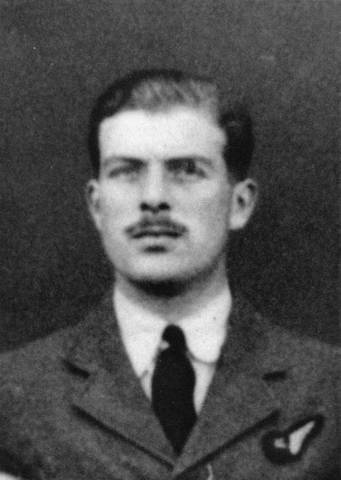
On 6th November 1941 he joined 57 Squadron based at RAF Feltwell in Norfolk teaming up with a regular crew to fly the Vickers Wellington, then Bomber Command's front line aircraft. He flew on 11 sorties over Europe including raids on the Channel ports, Emden, Hamburg, Essen and the Deutch Works Shipyards. On the 7th April 1942 he and his crew took of from RAF Feltwell at 2205 in Wellington Mk111 X3757 DX-A, on an operation to Hamburg. The raid involving 272 aircraft was the largest number put up by the RAF thus far, made up of 177 Wellingtons, 41 Hampdens, 22 Stirlings, 13 Manchesters, 12 Halifaxs and 7 Lancasters. 4 Wellingtons and 1 Manchester were lost, including Wellington X3757 which disappeared at around 0400 without a trace in the Wilmshaven area, a victim of anti-aircraft fire or a night fighter. Sergeant Norman Naylor was killed on active service on 8th April 1942 aged 23. He is commemorated on the Runnymede Memorial, Surrey for aircrew with no known grave.
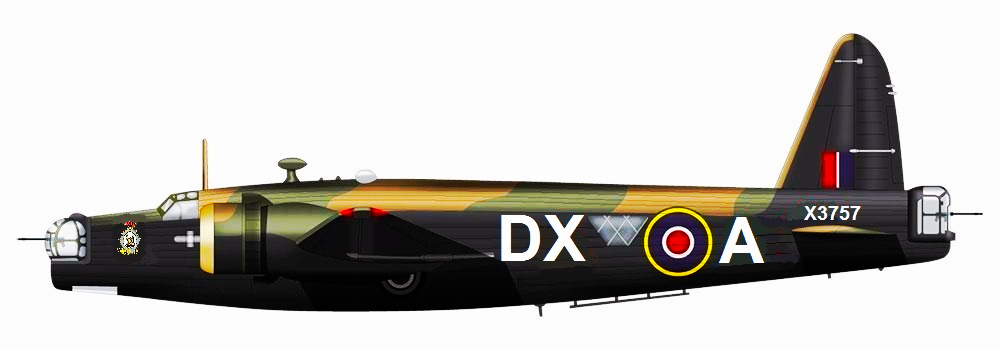

CORPORAL ALBERT VICTOR NEWMAN

He was born in April 1916, the son of Charles and Edith Newman of Little Compton and educated at Kingham Hill School. Before the war he worked as a market gardener living with Albert and Victoria Stares and their family at The Bungalow, Foxholes. He was also a Scout Leader and played in goal for the Church Army reserves.

.jpg?timestamp=1545562153865)
After the outbreak of war he enlisted into the local company of the 4th (Territorial) Battalion, Oxfordshire & Buckinghamshire Light Infantry. He married Violet Stares, the daughter of Albert Stares, in Chipping Norton in early 1941.
.jpg?timestamp=1545564487059)
.jpg?timestamp=1545564635758)

He was embodied into the 1st Battalion, The Oxfordshire & Buckinghamshire Light Infantry and promoted to Corporal. In October 1943 they started training for the Normandy Landings. The 1st Ox and Bucks landed on the Normandy beaches on 24th June 1944 as part of the 71st Infantry Brigade in the 53rd Welsh Division. On 25th June Operation Epsom began, it's intention to take the town of Caen, a vital objective for the British. This proved to be a formidable town to capture and the operation was unsuccessful. However, it did divert significant numbers of Germans away from the Americans. The Germans counter-attacked and the 1st Ox and Bucks moved to positions around the Odon bridgehead where it suffered from heavy German artillery fire. The Allies launched further attempts to capture Caen, the first Allied troops entered the city on 9th July, by then much of it had been destroyed. After holding the line the 1st Battalion's first major engagement with the enemy during the battle for Caen was the successful attack to capture the village of Cahier and a nearby mill.
Corporal Albert Newman was killed in action during this engagement on 16th July 1944. He was aged 28 and is buried in Brouay War Cemetery.
Shortly after the end of the war Joy Newman, who had worked in munitions during the conflict, visited her husband's grave in Brouay War Cemetery still marked by a wooden cross.


PRIVATE ALBERT GEORGE PICKERING
He was the son of Frank and Rose Pickering of The Green, Chipping Norton and had worked as a printer. He was also a member of the local company of the 4th(Territorial) Battalion, The Oxfordshire & Buckinghamshire Light Infantry, serving as a Private.
The 4th (Territorial) Battalion, The Oxfordshire and Buckinghamshire Light Infantry was sent to France in January 1940 to join the British Expeditionary Force as part of the 145th Brigade. The Wehrmacht launched its invasion of the Low Countries on 10th May 1940, shattering a period of the conflict that was known as the Phoney War. The German invasion of northern Belgium, where the BEF was located, was a diversion with the main attack being through the poorly-defended Ardennes forest. The BEF withdrew west towards the after the Dutch Army had surrendered. The 4th (Territorial) Battalion, The Oxfordshire and Buckinghamshire Light Infantry were involved in action along the line of the River Scheldt. The British force, having given a good account of themselves in the defence of the Scheldt, eventually withdrew into France, moving towards the area around Dunkirk. The evacuation of British forces back to Britain began on 26th May, known as Operation Dynamo The 4th Battalion then took part in the defence of Cassel, Nord until 29th May. They were eventually encircled by German forces near Watou and forced to surrender. The Battalion had split into two groups with the aim of reaching Dunkirk by going through the surrounding enemy forces. The Battalion sustained many casualties and had to surrender; becoming prisoners of war for the next five years. Only four soldiers from the two groups of 4th Oxfordshire and Buckinghamshire Light Infantry that had left Cassel returned to Britain.
Their sacrifice allowed more than 338,000 British, French and Belgian troops to be evacuated from Dunkirk..
Private Albert Pickering had been reported as missing on 10th May 1940 presumed killed in action between 10th May and 26th June 1940 whilst covering the Dunkirk evacuations. He was aged 21 and was buried by local people in Bavinchove Churchyard near Dunkirk, one of only 8 Commonwealth graves there.

LIEUTENANT GERALD WALTER PLUNKETT
Gerald Plunkett was born in Dublin in March 1918 to parents Oliver and Cordelia Plunkett. His father was a member of the Irish bar and had served with distinction in the First World War, after which he joined the Colonial Service. He was Governor-General of St Lucia before becoming a Judge in Egypt and Palestine. Gerald Plunkett was educated at Ampleforth College in Yorkshire and studied at St John's College, Cambridge where he attained a BA. He joined the 133rd Officer Cadet Training Anti-Aircraft Unit, Royal Artillery in 1938. He was commissioned as a 2nd Lieutenant on 24th August 1940 into the 231st Light Anti-Aircraft Battery, of the 42nd Light Anti-Aircraft Regiment, Royal Artillery, a Territorial Unit. From May 1941 they were defending London from air attacks, in August 1941 his elder brother Oliver was killed on active service. He was a Pilot Officer, navigator with the RAF when his Blackburn Botha crashed during a training flight at RAF Squires Gate, Blackpool. In December 1941 when the Regiment joined the 8th Army in North Africa coming under the orders of the 1st Armoured Division. They supported the Division at the Battle of Gazala, and the First and the Second Battles of El Alamein. Gerald Plunkett was promoted to Lieutenant in February 1942. They advanced into Tunisia in March 1943 where Lieutenant Plunkett was mortally wounded in action on 9th April 1943. He died of his wounds on the following day, 10th April 1943. He was aged 23 and is buried in Sfax War Cemetery.
He is also remembered on his brother's grave in Holy Trinity Churchyard in Chipping Norton.

PILOT OFFICER OLIVER PETER PLUNKETT
He was born in Dublin in March 1915 to parents Oliver and Cordelia Plunkett. His father was a member of the Irish bar and had served with distinction in the First World War, after which he joined the Colonial Service. He was Governor-General of St Lucia before becoming a Judge in Egypt and Palestine.
Oliver Plunkett emigrated to Argentina, sailing from London to Buenos Aires on the SS Stuart Star, a refrigerated cargo liner of the Blue Star Line, on 24th April 1937 in company with Kenneth Gadd. They were both working as fellmongers or fur dealers and Oliver was a member of Buenos Aires Rugby Union & Cricket Club. Oliver Plunkett left Argentina on 23rd July 1940 and returned to England and joined the Royal Air Force Volunteer Reserve. He was commissioned as a Pilot Officer and posted to No 3 School of General Reconnaissance as a Navigator under training, based at RAF Squires Gate Blackpool. They flew the 4 seat Blackburn B26 Botha Mk1, originally designed as a reconnaissance and torpedo bomber. The aircraft was underpowered and unstable and by the end of 1940 relegated to a training role. On 16th August 1941 he was aboard Botha L6315 on a training flight. On coming back into land at Squires Gate the aircraft crashed on the approach to runway No 1. The pilot was badly injured and taken to Victoria hospital. Oliver Plunkett, 26, along with fellow pupil navigator Pilot Officer Robert Simpson Hayward, 27, and wireless operator/observer Aircraftman 2nd class Charles Mair, 21, were killed in the crash.
Pilot Officer Oliver Plunkett was killed on active service on 16th August 1941. He was aged 26 and is buried in Holy Trinity Roman Catholic Churchyard, Chipping Norton.
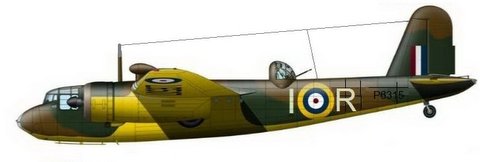

PRIVATE DESMOND JOHN SIMS
He was the son of Hubert and Annie Sims of Market Street, Chipping Norton. His father had served with the Somerset Light Infantry in the First World War and lost a brother in the conflict. He enlisted as a Private in the 2nd Battalion, The Duke of Cornwall's Light Infantry.
The 2nd Battalion, The Duke of Cornwall's Light Infantry was part of the 10th Infantry Brigade and had been sent to Algeria and Tunisia in 1943. They then moved into Italy and saw hard fighting in the Battle of Monte Cassino between 17th January and 18th May 1944.
Private Desmond Simsdied as a result of an accident on 20th August 1944 aged 19 during the Allied advance on Rome. He is buried in Assissi Military Cemetery.

SERGEANT NICHOLAS JOHN STOCKFORD
He was born in Steeple Barton in March 1922, to parents George and Elizabeth Stockford, who ran a grocery shop in the village. He attended Chipping Norton County School between 1933 and 1938 and joined the RAF as an engineering apprentice on leaving school aged 16. Between October 1940 and October 1943 he served in South Africa as an engine fitter, returning to England to train for flying duties and was posted to 207 Squadron as a Flight Engineer, with the rank of Sergeant.
On the night of 3rd May 1944 he took off aboard Lancaster EM-F ND556 of 207 Squadron, at 2205. The target was a massive German military camp situated near the village of Mailly-le-Camp that consisted of 20,000 troops and a Panzer Division of tanks. Nineteen squadrons of Lancaster bombers were involved, 346 aeroplanes in total, plus 14 Mosquitos, dropping a total of 1,500 tons of bombs and causing considerable damage to enemy weapons and equipment and virtually wiping out the entire Panzer division. Although the target was accurately marked, communication difficulties led to a delay in the main force attack, during which Luftwaffe fighters intercepted the force and claimed 42 Lancasters (11.6% of the total force). Three hundred personnel were either killed or reported as missing. Sergeant Stockford is pictured with his crew, below.
.jpg?timestamp=1698303035808)
ND556 was attacked by German Focke-Wulf 190 night fighters, evading one but falling to a second, the dinghy hatch was blown off, the bomb bay was hit and a fire started. The stricken Lancaster crashed at Chaintreaux in Seine-et-Marne, the pilot Flight Sergeant Leslie Lissette RNZAF remained at the controls. He was critically injured and died in a French hospital. He shares a grave in Chaintreaux with the rear gunner Sergeant Ronald Ellis, who lived in Duns Tew.
.jpg?timestamp=1698303278217)
After bailing out he following account comes from the statement he made on his return home:
The bomb aimer bailed out first and I followed him. I landed in a wood some miles north of Ferrieres. I freed ny parachute from the tree in which it had become entangled and buried it, together with my mae west, in the undergrowth. I set out at once, walking south by my compass, and continued across the fields for about three hours, when I hid in a wood until dawn. I removed my brevet and service chevrons and threw away my loose silver. I could see that I was near a small village, and later that morning (4th May) I moved towards it. About mid-day , as I was hiding in a hedge, and though they saw me, they did not stop. Half an hour later, an old man came straight towards where I was hiding and said he was the father of the two girls who had seen me and reported my presence. He lold me that I had reached Fontenay. When he heard that I intended to make my way south, he warned me against going through Montargis, which, he said, was full of Germans. At 1400 I set out in what I thought was a south-westerly direction, so as to make a detour round Montargis. I crossed the railway and the main road and finally reached a stream, which I followed, thinking it was flowing in the direction I wanted to go. After scrambling through thick undergrowth in my efforts to follow the course of the stream. I came out on a secondary road leading to a bridge across a stream. I crossed the bridge and then realised I was hopelessly lost. Seeing a man working in a woodyard, I beckoned to him and asked him where I was. He told me I was on the outskirts of the village of Nargis. I made my way towards the town and then hid in woods for the night.
I set out again early next morning (5th May) for Chateau-Landon. Before I reached the town I decided to seek help at a farm. There were several people working in the fields, bu they took no notice of me. I finally managed to attract the attentions of an old man, to whom I declared myself. He took me back to the house and gave me some wine to drink. People at once crowded round and offered me food, which I refused as I was not hungry. They were just discussing the question of providing civilian clothes for me, when a woman came running up and told me I must leave at once, as the farmer had informed the authorities of my presence. I ran down the hill, through some woods and across a stream, finally crawling into the undergrowth on the far side, from where I was able to keep a good lookout for anyone searching for me. About 1500 a man saw me and came towards me. By this time I was extremely hungry, as the only food I had eaten since bailing out was some Horlicks tablets from my escape box. The man promised to return in an hours time with some food. He returned shortly afterwards, however, without the food, which he said he would not give me until until I had written in his notebook that he had helped me. I was feeling desperate by this time, so I did as he asked me. The man then disappeared for several hours, and it was not until 1900 he returned with a loaf of bread and some cold potatoes. he was very nervous and asked me to leave at once. I continued on my way towards Chateau-Landon and reached the outskirts that evening. I passed several people, but they took no notice of me. I entered a small coppice and rested there for a while. Shortly after several youths passed close by my hiding place whistling "Tipperary". I realised they were looking for me and beckoned to them. They told me they were members of the Maquis, though I did not believe them as they had no arms. I told them I wanted to get to Beaumont, whereupon they led me out of the town and left me on the road to Mondeville. That night I lay up in a wood just outside the town. The next morning (6th May) I walked through Mondeville and reached the outskirts of Beaumont. I stayed near the town all day, hoping to contact someone who could help me, but saw no one. Early next morning I walked through Beaune-Le-Rolande and continued along the road. I was feeling very weak by this time, so I entered a field and slept for some hours. At 1700 I set out again and walked through Boiscommun which was very deserted. Beyond the town I saw an old man working in the fields and asked him the way to Vitry. He pointed to the road I should take and I continued along it. I passed several people, who completely ignored me, though I heard one man mutter "les bosches" as I passed. A little further on I came to a clearing in the woods beside the side of the road. I saw a water trough standing in the clearing and went straight towards it, as I was feeling extremely thirsty. As I was drinking I saw three people standing in front of a house watching me. I went up to them and asked for something to eat. After they had given me some food, I declared myself to them and was immediately invited inside. The owner of the house said that his son was away at the moment, but when he returned he would be able to put me in touch with an organisation. His son returned shortly afterwards and said he would be able to help me. I spent the night in the garage attached to the house, and the next day the son went to see a member of an organisation. That evening (8th May) I was visited by a young woman, and from this point my journey was arranged for me.
Nicholas Stockford returned home via the "Comet Line" escape route over the Pyrenees and into Portugal. On the night of 14th/15th July 1944 he arrived at Whitchurch Airport, near Bristol on a civil airliner from Lisbon. His papers were made out for a John White a civilian escapee from Vittel internment camp in France. He revealed his true identity to the security guard.
On 8th August 1944 he married Joyce Jones, of Heythrop, at Chipping Norton Methodist Church, living at 30, Spring Street, Chipping Norton. He tragically died suddenly from pleurisy at RAF Longtown near Carlisle on 18th September 1944 aged 22. He buried in Heythrop St Nicholas Churchyard and also remembered on the War Memorial there.

PRIVATE HARRY WILLIAM WILSON
He was born in October 1924, the son of William and Emily Wilson of 16, New Street, Chipping Norton. He enlisted as a Private with the 5th Battalion The Hampshire Regiment.
The 5th Battalion of the Hampshire Regiment was a Territorial Battalion that formed part of the 128th Hampshire Brigade. In January 1943, the brigade left Britain with the rest of the 46th Infantry Division, for North Africa, as part of Operation Torch. They disembarked at Algiers on 17th January, moving to Bone, where it remained until the end of January, when the brigade moved to Hunts Gap.
The 5th Battalion was sent 12 miles further ahead to Sidi Nsir and was attacked in overwhelming strength in February 1943 as the Germans began Operation "Ox Head", a Corps level assault by German Paratroopers, elements of 10th Panzer Division and the 501st Heavy Tank Battalion. At 1700 ‘B’ Company of the 5th Battalion, reduced to 30 men, was overrun. At dusk, the battalion considered its position untenable, and it withdrew to a feature known as "Hampshire Farm". The German force was delayed for one critical day.
Later in the month, the Hampshire Brigade was attacked at Hunt's Gap by the German force that had been delayed at Sidi N'sir. 2/4th was the main Battalion engaged, with 1/4th Battalion in support. Extensive minefields and heavy dive bombing kept the German tanks at bay. On 5th April 1943, the brigade handed over its positions and moved 100 miles south to El Ala. The 128th Brigade subsequently captured the Fondouk Gap, allowing the 6th Armoured Division to pass through and debouche onto the Kairouan Plain. In April 1943, the 128th Infantry Brigade attacked Bou Arada. Tunis fell and the North African Campaign was over in May 1943.
The 128th Infantry Brigade was one of three British brigades that made an assault landing at Salerno in Italy as part of British X Corps in September 1943. The landing was opposed by shore batteries firing shrapnel, and the beaches were raked by machine gun fire. The 5th Battalion had been landed in the wrong place and suffered heavily. A German counter-attack overran ‘B’ Company and the Battalion HQ of 5th Battalion. The 5th Battalion lost 40 men killed and over 300 were wounded or taken prisoner.
On 12th September, the Germans started a general assault against the Salerno bridgehead, which made good progress. The 128th Brigade was in the hills above Salerno, and the fighting was hard, but on 20th September the Germans began to withdraw northwards, and the pressure eased. The 5th Battalion suffered 29 officer and over 400 other rank casualties. The 128th Brigade, still part of the X Corps, moved up to the River Volturno, behind which the Germans had withdrawn. On 10 October, the 1/4th Battalion captured the town of Castel Volturno, alongside the river, and on 12 October the 1/4th made a night assault across the river, establishing a small bridgehead. The 2nd and 5th battalions moved across the river in support, but the entire 128th Brigade was soon engaged in a stiff fire-fight. The brigade advanced some 2,500 yards, and then dug in behind a canal as the Germans bought up tanks. The brigade remained in the low-lying, swampy, mosquito-ridden land between the river and the canal until the Germans withdrew due to a breakthrough elsewhere. The 128th Brigade was then taken out of the line for rest and recuperation.
In November 1943, the Hampshire Brigade moved up to the River Garigliano. It was relieved on 11th January, and moved back to the River Volturno. They were selected as the Assault Brigade of the 46th Infantry Division, and trained in river crossings. Then, in January 1944, the Hampshire Brigade made a night assault across the swift flowing River Garigliano. The brigade had severe problems getting the boats through the minefields down to the river, and in the darkness confusion reigned. Only a few men managed to get across, and these were withdrawn at daylight.
The 5th Battalion was put under the command of the 138th Infantry Brigade, part of the 46th Division, to assault Mounts Ornito and Cerasola in February 1944. The assault met little opposition, although the Germans put in spirited counter-attacks on Mount Ornito, which were all driven off. However, as the days passed, the casualties mounted from heavy shelling, the bare rock made cover difficult. In eight days, the 5th Battalion suffered 200 casualties. Supply was particularly difficult, as supplies had to be carried up by mules and porters for 3 to 4 hours from the nearest road. On 7th February, the 5th Battalion attacked Mount Cerasola, a successful assault.
Private Harry Wilson was killed in action during the attack on 7th February 1944. He aged 20 and is buried in Minturno Military Cemetery near Naples.

FLYING OFFICER PETER PATRICK WOOD
He married Alice Lilian Perry in Romford in the autumn of 1942. They lived at Midway Grange in Chipping Norton and had one daughter, Catherine born in 1944 and had joined the Royal Air Force Volunteer Reserve.
was serving as a Flying Officer with the when he died on 10th April 1945 aged 25. He is buried in Khartoum War Cemetery.
Flying Officer Peter Wood died on 10th April 1945 at El Fashir airfield in Sudan from a shot gun wound to the head. He was aged 25. He is buried in Khartoum War Cemetery. 
Some of the information and photographs on this page come from the Book of Remembrance in Chipping Norton Museum which was collected by Josephine Madge Byford (9th December 1919 to 9th February 1995).
Madge had served with The Oxfordshire and Buckinghamshire Light Infantry on an AA battery between 1939 and 1945. After the war ended she volunteered for the Red Cross, and worked to alleviate the suffering of women and children who had been incarcerated at Belsen concentration camp.
